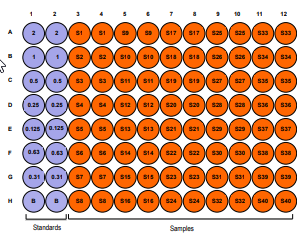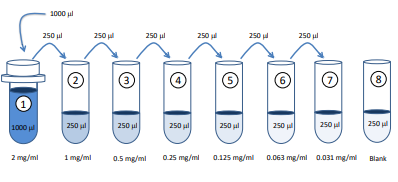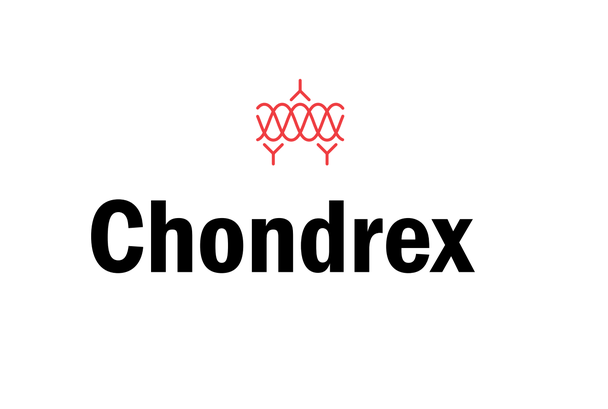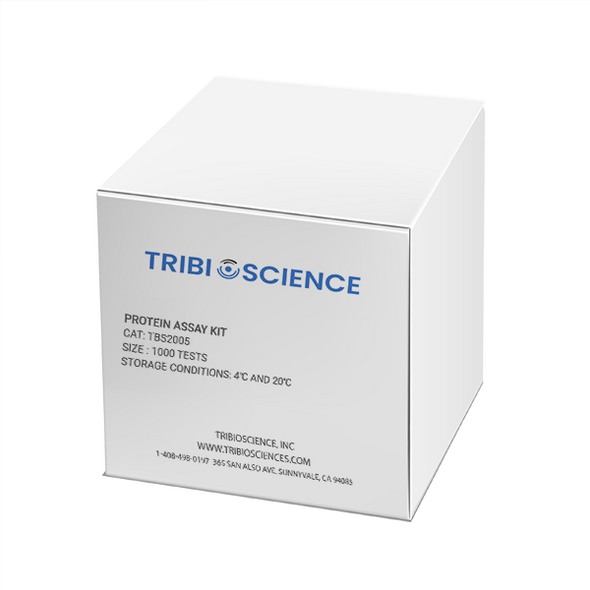Description
Bromophenol Blue (BPB) Protein Assay Kit - Cat Number: 6026 From Chondrex.
Research Field: ECM
Clonality: N/A
Cross-Reactivity:
Host Origin: N/A
Applications: N/A
Isotype: N/A
Detection Range: 2 mg/ml-0.031 mg/ml
Sample Type: Cultured Cells, Urine
Concentration: N/A
Immunogen:
PRODUCT SPECIFICATIONS
DESCRIPTION: Assay kit to quantify proteins (proteinuria)
FORMAT: 96-well ELISA Plate with removeable strips
ASSAY TYPE: Colorimetric Assay
ASSAY TIME: 5 minutes
STANDARD RANGE: 2 mg/ml to 0.03 mg/ml
NUMBER OF SAMPLES: Up to 40 (duplicate) samples/plate
SAMPLE TYPES: Urine, Serum, and Plasma
RECOMMENDED SAMPLE DILUTIONS: Varies
CHROMOGEN: N/A (read at 610 nm)
STORAGE: 4°C
VALIDATION DATA: Intra-Assay (1.7-5.2%)/Inter-Assay (4.4-9.8%)/Spiking Test (93-105%)
NOTES:
INTRODUCTION
Bromophenol blue (BPB), a phenolphthalein anionic dye, binds to proteins under neutral to acidic conditions. From this attribute, BPB can
determine protein levels in samples, especially in solubilized cultured cells and cell membrane proteins with high concentrations of surfactants
(8). This is an advantage over the widely used Coomassie blue protein assay which is affected by the presence of surfactants in the samples.
Proteinuria, the presence of an excess of serum proteins in the urine, is a useful marker of renal disease. In addition, the pathophysiology of
proteinuria can be divided into tubular or glomerular dysfunction. For example, albumin, a plasma protein, may better define pathological
proteinuria of glomerular origin while beta 2-microglobulin indicates tubular origin (6, 7). Usually, urinary protein levels are determined using
a dipstick assay. However, this method is affected by urine volume and color, which can lead to inaccurate results (1-3). Therefore, as a
simple, precise, and accurate alternative for quantifying proteinuria, a BPB protein assay is available. The results may better reflect
glomerular albuminuria due to its higher affinity for albumin rather than globulin (4, 5).
Chondrex, Inc. provides a BPB Protein Assay Kit (Cat # 6026) to evaluate proteinuria in mice and rats, as well as a Rat Urinary Protein Assay
Kit (Catalog # 9040), a Rat Albumin Detection ELISA Kit (Catalog # 3020), and a Mouse Albumin Detection ELISA Kit (Catalog # 3012).
KIT COMPONENTS

ASSAY OUTLINE

PLATE LAYOUT

NOTES BEFORE USING ASSAY
NOTE 1: It is recommended that the standard and samples be run in duplicate.
NOTE 2: Warm up all buffers to room temperature before use.
NOTE 3: Crystals may form in Wash Buffer, 20X when stored at cold temperatures. If crystals have formed, warm the wash buffer by placing
the bottle in warm water until crystals are completely dissolved.
NOTE 4: Measure exact volume of buffers using a serological pipet, as extra buffer is provided.
NOTE 5: This kit contains animal components from non-infectious animals and should be treated as potential biohazards in use and for
disposal.
ASSAY PROCEDURE
1. Prepare Standard Dilutions: The recommended standard range is 0.031 - 2 mg/ml. Dissolve one vial of Standard in 1 ml of PBS for
the 2 mg/ml standard and serially dilute with PBS. For example, mix 200 µl of the standard (2 mg/ml) with an equal volume of PBS to
make a 1 mg/ml solution, and then repeat it five more times for 0.5, 0.25, 0.125, 0.063, and 0.031 mg/ml solutions. The remaining 2
mg/ml standard stock may be stored at 4°C for future use. Chondrex, Inc. recommends making fresh serial dilutions for each assay.

2. Prepare Sample Dilutions: Dilute samples with PBS. It is recommended to use 2-3 different dilutions if the sample albumin level is
unknown.
3. Prepare Dye Solution: Mix 150 µl of Solution A with 50 µl of Solution B for each well just before use. For example, 8 samples, 7-point
standards, and one blank (all in duplicate) will require 6.4 ml of the Dye Solution. Mix 4.8 ml of Solution A with 1.6 ml of Solution B.
4. Add Standards and Samples: Add 50 µl of standards, PBS (Blank), and samples to designated wells.
5. Add Dye Solution: Add 200 µl of the dye solution into all wells. Incubate at room temperature for 5 minutes.
6. Read Plate: Read the OD values at 610 nm. If the OD values of samples are greater than the OD values of the highest standard, reassay the samples at a higher dilution.
KIT COMPONENTS






